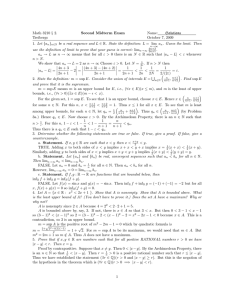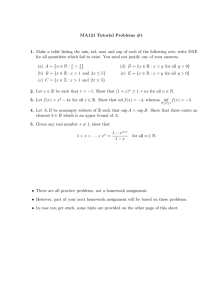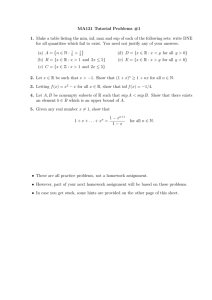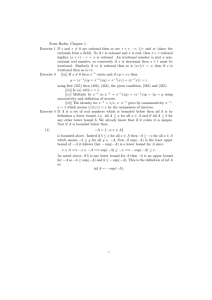Max, Min, Sup, Inf
advertisement
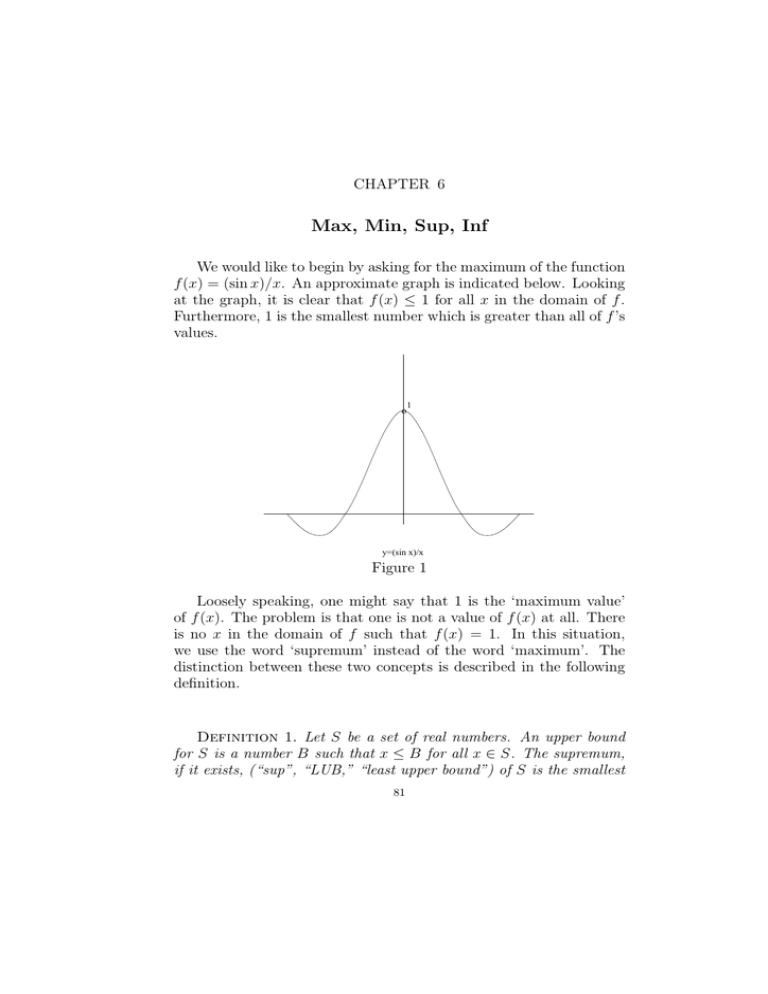
CHAPTER 6
Max, Min, Sup, Inf
We would like to begin by asking for the maximum of the function
f (x) = (sin x)/x. An approximate graph is indicated below. Looking
at the graph, it is clear that f (x) ≤ 1 for all x in the domain of f .
Furthermore, 1 is the smallest number which is greater than all of f ’s
values.
o
1
y=(sin x)/x
Figure 1
Loosely speaking, one might say that 1 is the ‘maximum value’
of f (x). The problem is that one is not a value of f (x) at all. There
is no x in the domain of f such that f (x) = 1. In this situation,
we use the word ‘supremum’ instead of the word ‘maximum’. The
distinction between these two concepts is described in the following
definition.
Definition 1. Let S be a set of real numbers. An upper bound
for S is a number B such that x ≤ B for all x ∈ S. The supremum,
if it exists, (“sup”, “LUB,” “least upper bound”) of S is the smallest
81
82
6. MAX, MIN, SUP, INF
upper bound for S. An upper bound which actually belongs to the set
is called a maximum.
Proving that a certain number M is the LUB of a set S is often
done in two steps:
(1) Prove that M is an upper bound for S–i.e. show that M ≥ s
for all s ∈ S.
(2) Prove that M is the least upper bound for S. Often this is
done by assuming that there is an ǫ > 0 such that M − ǫ
is also an upper bound for S. One then exhibits an element
s ∈ S with s > M − ǫ, showing that M − ǫ is not an upper
bound.
Example 1. Find the least upper bound for the following set and
prove that your answer is correct.
1 2 3
n
S = { , , ,...,
...}
2 3 4
n+1
Solution: We note that every element of S is less than 1 since
n
<1
n+1
We claim that the least upper bound is 1. Assume that 1 is not
the least upper bound,. Then there is an ǫ > 0 such that 1 − ǫ is also
an upper bound. However, we claim that there is a natural number
n such that
n
.
1−ǫ<
n+1
This inequality is equivalent with the following sequence of inequalities
n
<ǫ
1−
n+1
1
<ǫ
n+1
1
<n+1
ǫ
1
− 1 < n.
ǫ
6. MAX, MIN, SUP, INF
83
Reversing the above sequence of inequalities shows that if n > 1ǫ − 1,
n
then 1 − ǫ < n+1
showing that 1 − ǫ is not an upper bound for S.
This verifies our answer.
If a set has a maximum, then the maximum will also be a supremum:
Proposition 1. Suppose that B is an upper bound for a set S
and that B ∈ S. Then B = sup S.
Proof Let ǫ > 0 be given. Then B − ǫ cannot be an upper bound
for S since B ∈ S and B > B − ǫ, showing that B is indeed the least
upper bound.
Example 2. Find the least upper bound for the following set and
prove that your answer is correct.
1 2 3
n
T = {1, , , , . . . ,
. . . }.
2 3 4
n+1
Solution: From the work done in Example 1, 1 is an upper bound
for S. Since 1 ∈ S, 1 = sup S.
Example 3. Find the max, min, sup, and inf of the following set
and prove your answer.
S={
2n + 1
| n ∈ N }.
n+1
Solution: We write the first few terms of S:
ª
© 3 5 7 9 11
, , , , ,... .
S=
2 3 4 5 6
The smallest term seems to be 32 and there seems to be no largest
=
term, although all of the terms seem to be less than 2. Since limn→∞ 2n+1
n+1
2 we conjecture that:
(a) There is no maximum, (b) sup S = 2, and (c) min S = inf S =
3
.
2
Proof
Sup
84
6. MAX, MIN, SUP, INF
We must first show that 2 is an upper bound–i.e.
2n + 1
<2
n+1
2n + 1 < 2n + 2
1<2
which is always true. Reversing the above argument shows that 2 is
an upper bound.
Next we show that 2 is the least upper bound. If 2 is not the
LUB, there is an ǫ > 0 such 2 − ǫ is an upper bound. However, we
claim that there are n ∈ N such that
2n + 1
2−ǫ<
n+1
showing that 2 − ǫ is not an upper bound.
To prove our claim, note that the above inequality is equivalent
with
2n + 1
−2
−ǫ <
n+1
1
ǫ>
n+1
1
n> −1
ǫ
Since there exist n ∈ N satisfying the above inequality, our claim is
proved. Hence 2 is the LUB.
Next we show that 2 is not a maximum. This means showing that
there is no n such that
2n + 1
2=
.
n+1
This however is equivalent with
2(n + 1) = 2n + 1
2n + 2 = 2n + 1
2=1
which is certainly false.
Next we prove that min S = 32 . We first note that
2·1+1
3
=
.
2
1+1
3
2
∈ S since
6. MAX, MIN, SUP, INF
85
Hence, it suffices to show that 32 is a lower bound which we do as
follows:
2n + 1
3
≥
n+1
2
2(2n + 1) ≥ 3(n + 1)
n≥1
which is true for all n ∈ N. Reversing the above argument shows that
3
is a lower bound.
¤
2
The central question in this section is “Does every non-empty set
of numbers have a sup?” The simple answer is no–the set N of natural
numbers does not have a sup because it is not bounded from above.
O.K.–we change the question:“Does every set of numbers which is
bounded from above have a sup?” The answer, it turns out, depends
upon what we mean by the word “number”. If we mean “rational
number” then our answer is NO!.
Recall that the set of integers is the set of positive and natural
numbers, together with 0. I.e.
Z = {0, ±1, ±2, . . . , ±n, · · · | n ∈ N}.
The set of rational numbers is the set
p
Q = { | p, q ∈ Z, q 6= 0}.
q
Thus, for example, 23 and − 97 are elements of Q. In Chapter 9 (The√
orem 2) we prove that 2 is not rational.
Now, let S be the set of all positive rational numbers r such that
r2 < 2. Since the square root function is increasing on the set of
positive real numbers,
√
S = {0 < r < 2 | r ∈ Q}.
√
Clearly, 2 is an upper bound for S. It is also a limit of values
from S. In fact, we know that
√
2 = 1.414213562 + .
Each of the numbers 1.4, 1.41, 1.414,√1.4142, etc. is rational
and
√
2.
Thus,
sup
S
=
2.
(See
has square less than 2. Their
limit
is
√
Exercise 6 below.) Since 2 is irrational, S is then an example of a
set of rational numbers whose sup is irrational.
Suppose, however, that we (like the early Greek mathematicians)
only knew about rational numbers. We would be forced to say that S
86
6. MAX, MIN, SUP, INF
has no sup. The fact that S does not have a sup in Q can be thought
of as saying that the rational numbers do not completely fill up the
number line; there is a missing number “directly to the right” of S.
The fact that the set R of all real numbers does fill up the line is such
a fundamentally important property that we take it as an axiom: the
completeness axiom. (The reader may recall that in Chapter I, we
mentioned that we would eventually need to add an axiom to our
list. This is it.) We shall also refer to this axiom as the Least Upper
Bound Axiom. (LUB Axiom for short.)
Least Upper Bound Axiom: Every non-empty set of real numbers
which is bounded from above has a supremum.
The observation that the least upper bound axiom is false for
Q tells us something important: it is not possible to prove the least
upper bound axiom using only the axioms stated in Chapters 1 and
2. This is because the set of rational numbers satisfy all the axioms
from Chapters 1 and 2. Thus, if the least upper bound axiom were
provable from these axioms, it hold for the rational numbers.
Of course, similar comments apply to minimums:
Definition: Let S be a set of real numbers. A lower bound for S
is a number B such that B ≤ x for all x ∈ S. The infinum (“inf ”,
“GLB,” “greatest lower bound”) of S, if it exists, is the largest lower
bound for S. A lower bound which actually belongs to the set is called
a minimum.
Fortunately, once we have the LUB Axiom, we do not need another axiom to guarantee the existence of inf’s. The existence of inf’s
is a theorem which we will leave as an exercise. (Of course, we could
have let the existence of inf’s be our completeness axiom, in which
case the existence of sup’s would be a theorem.)
Greatest Lower Bound Property: Every non-empty set of real
numbers which is bounded from below has a infimum.
Proving that a certain number M is the GLB of a set S is similar
to a LUB proof. It requires:
6. MAX, MIN, SUP, INF
87
(1) Proving that M is a lower bound for S–i.e. proving that
M ≤ s for all s ∈ S.
(2) Proving that M is the greatest lower bound for S. Often this
is done by assuming that there is an ǫ > 0 such that M + ǫ
is a lower bound for S. One then exhibits an element s of
S satisfying s < M + ǫ, showing that M + ǫ is not a lower
bound for S.
Example 4. Prove that the inf of S = (1, 5] is 1.
Solution: By definition S is the set of x satisfying 1 < x ≤ 5. Hence
1 is a lower bound for S. Suppose that 1 is not the GLB of S. Then
there is an ǫ > 0 such that 1 + ǫ is also a lower bound for S. To
contradict this, we exhibit x ∈ S such that 1 < x < 1 + ǫ. Since
ǫ
0< <ǫ
2
we see that
ǫ
x=1+
2
satisfies
1 < x < 1 + ǫ.
Since 1+ǫ is (by assumption) a lower bound for S and 5 ∈ S, 1+ǫ ≤ 5,
showing that x ∈ (1, 5]. Thus, 1 + ǫ is not a lower bound, proving
that 1 is the greatest lower bound.
Example 5. Find upper and lower bounds for y = f (x) for x ∈
[−1, 1.5] where
f (x) = −x4 + 2x2 + x
Use a graphing calculator to estimate the least upper bound and the
greatest lower bound for f (x).
Solution: From the triangle inequality
|f (x)| = | − x4 + 2x2 + x| ≤ |x4 | + |2x2 | + |x|
= |x|4 + 2|x|2 + |x|
The last quantity is largest when |x| is largest, which occurs when
|x| = 1.5. Hence
|f (x)| ≤ 1.54 + 2(1.5)3 + 1.5 = 13.3125
88
6. MAX, MIN, SUP, INF
Hence, M = 14 is an upper bound and M = −14 is a lower bound.
As a check, we graph y = −x4 + 2x2 + x with xmin= −.5, xmax= 1.5,
ymin= −15 and ymax= 15, as well as the lines y = 14 and y = −14.
Since the graph lies between the lines, the value of M is acceptable,
although considerably larger than necessary. To estimate the least
bound, we trace the curve using the trace feature of the calculator,
finding that the maximum and minimum y-values are approximately
2.0559 and −.130 respectively. These values are (approximately) the
least upper bound and the greatest lower bound respectively.
Remark: It is important to note that in the preceding example,
the values of the function at the end points of the interval are not
bounds for the function because f (x) is not monotonic (i.e. it is
neither increasing nor decreasing) over the stated interval. On the
other hand, the largest value of |x|4 + 2|x|2 + |x| is at the largest
endpoint because this function increases as |x| increases.
The next example uses both the triangle inequality and the observation that making the denominator of a fraction smaller increases
its value.
Example 6. Find a bound for y = f (x) for x ∈ [−2, 2] where
x3 − 3x + 1
f (x) =
1 + x2
Solution: We note that
¯ x3 − 3x + 1 ¯ |x3 − 3x + 1|
¯
¯=
1 + x2
1 + x2
Since x2 > 0, we see
x2 + 1 > 1
1
1
< =1
2
x +1
1
Hence
|x3 − 3x + 1|
≤ |x3 − 3x + 1| ≤ |x3 | + |3x| + 1 ≤ 23 + 3 · 2 + 1 = 15
1 + x2
Thus, our bound is M = 15.
6. MAX, MIN, SUP, INF
89
In all of the examples considered above, the least upper bound
for f (x) is the maximum of f (x). This is always the case if f (x) has
a maximum. Similarly, the greatest lower bound is the minimum of
f (x) if f (x) has a minimum.
In Chapter 4, we studied sequences which diverge because they
tend to infinity. Another class of sequences that have no limit are ones
which might be dubbed “wishy-washy.” These are sequences that
can’t make up their minds what their limit is, tending simultaneously
to several numbers. An example is
n + (−1)n n
an =
n+1
The first 10 values are listed below.
n 1 2 3 4 5 6 7 8 9 10
an 0 1.33 0 1.60 0 1.71 0 1.78 0 1.82
It appears that some values approach (in fact equal) 0 while others
approach 2. Indeed, for odd n
n−n
=0
an =
n+1
which tells us that if the limit exists, it must be 0. For even n
n + n 2n
an =
n+1n+1
which tends to 2. From Proposition 1, a sequence can have only one
limit. Hence, there is no limit.
A related type divergence is what might be referred to as “wandering,” where values wander in a seemingly random manner, never
getting close to particular number. An example is
an = cos n.
The first 10 values are listed below.
n
1
2
3
4
5
6
7
8
9
10
cos n .540 −.416 −.990 −.654 .284 .960 .754 −.146 −.911 −.839
There certainly seems to be no tendency toward any one number.
A sequence an is non-decreasing if
a 1 ≤ a2 ≤ a 3 ≤ · · · ≤ a n < . . .
The sequence an is increasing if each of the above inequalities is strict.
90
6. MAX, MIN, SUP, INF
For example, an = n2 is increasing :
1 < 22 < 32 < 42 < . . .
The sequence from Example 1 is also increasing:
1
2
3
4
< < < < ...
2
3
4
5
The two preceding sequences demonstrate that an increasing sequence can either go to infinity or can converge. However, an increasing sequence cannot wander; once it has exceeded a certain value, it
can never return to that value. Hence we arrive at the following
theorem:
Theorem 1 (Bounded Increasing Theorem). For a non-decreasing
sequence an , either limn→∞ an exists or limn→∞ an = ∞.
Proof limn→∞ an = ∞ implies that for all M > 0 there is an N such
that an ≥ M for all n ≥ N . For a non-decreasing sequence, this is
equivalent with the statement that for all M there is an n such that
an ≥ M . Hence if limn→∞ an 6= ∞, there is an M such that an < M
for all n. Thus
S = {a1 , a2 , . . . , an , . . . }.
is bounded from above. Let a = sup S. Then
an ≤ a
for all n. Furthermore, since a is the smallest upper bound, a − ǫ is
not an upper bound for any ǫ > 0. Hence, for all ǫ > 0, there is at
least one aN such that
a − ǫ < aN ≤ a.
However, since an is increasing and a is an upper bound for S, we see
that for all n ≥ N ,
aN ≤ an ≤ a.
It follows that for all n ≥ N ,
a − ǫ ≤ an ≤ a + ǫ
proving that a is the limit of an , as desired.
The bounded increasing theorem is one of the most important
ways of proving that sequences converge. In particular, we will make
good use of in Chapters 7 and 8.
6. MAX, MIN, SUP, INF
91
There is, of course, nothing special about increasing as opposed to
decreasing. It is an immediate consequence of the Bounded-Increasing
Theorem that a decreasing sequence which is bounded from below
also has a limit. (See Exercise 10 below.)
We have already used repeatedly, without comment, a consequence of the GLB axiom. For example, in our formal solution to
Example 2 in Chapter 4, we said “. . . let ǫ > 0 be given and let
n > 1/ǫ.” Certainly, we know from experience that there are natural numbers n greater than 1/ǫ. However, none of the axioms from
Chapters 1 and 2 tell us that such numbers exist. Their existence
follows from the following theorem. We leave it as an exercise (Exercise 11 below) to explain how this property follows from the GLB
axiom.
Theorem 2 (Archimedian Property). For all numbers M there
is a natural number n such that n > M .
Exercises
(1) Compute the sup, inf, max and min (whenever these exist)
for the following sets. 1
(a) {1 + 1/n | n ∈ N}
(b) [0, 2)
2 +15
(c) { nn+1
| n ∈ N}
(d) {x | x ∈ Q and x2 < 2}
(e) {y | y = x2 − x + 1 and x ∈ R}
(f) {x | x2 − 3x + 2 < 0 and x ∈ R}
(g) { n1 − m1 | n, m ∈ N}
n
(h) {1 + 1+(−1)
|n ∈ N}
n
(i) { 12 , 31 , 32 , 14 , 43 , 51 , 52 , 35 , 54 , . . . }. (This is a list of the fractions in the interval (0, 1). The pattern is that we
list fractions by increasing value of the denominator.
For a given value of denominator, we go from smallest
to largest, omitting fractions which are not in reduced
form.)
(j) {n/(1 + n2 ) | n ∈ N}
(k) {3n2 /(1 + 2n2 ) | n ∈ N}
(l) {n/(1 − n2 ) | n ∈ N, n > 1}
1In
set theory, the symbol ‘|’ is read “where.” Thus, the set in part (a) is the
set of numbers of the form 1 + 1/n where n is a natural number.”
92
6. MAX, MIN, SUP, INF
{(1 − 2n2 )/3n2 | n ∈ N}
2
{2n2 /(3n
− 1) | n ∈ N}
√
2
{3n/
√ 1 + n | n ∈ N}
{3/ 1 + 2n2 | n ∈ N}
{ nn−1
2 +5 | n ∈ N}
Hint: In the proof of the upper bound (which is requested in Exercise 2), you will discover that you need
to prove n2 − 7n + 12 ≥ 0. Factor this polynomial and
determine when it can be negative.
(r) { 3n+1
| n ∈ N}
n+1
(2) Prove your answers in Exercise 1.
(3) In Example 5, use a graphing calculator to estimate the sup
and the inf for f (x).
(4) For the following functions f (x), (i) find a number M such
that |f (x)| ≤ M for all x in the stated interval. (ii) Use a
graph to estimate the sup s and inf t for f (x). Sketch your
graph on a piece of paper. (iii) As evidence for the statement
that s is the LUB, find an x such that f (x) > s − ǫ for the
stated value of ǫ. (iv) As evidence for the statement that t
is the GLB, find an x such that f (x) < t + ǫ for the stated
value of ǫ.
(m)
(n)
(o)
(p)
(q)
(a)
f (x) = x5 − x4 + x3 − x2 + x − 1
3
(b)
(c)
(d)
(e)
(f)
2
x ∈ [−1, 1],
x − 3x
x ∈ [0, 2], ǫ = .01
1 + x + x2
f (x) = x3 − 3x2 + 2x − 1 + 5 sin x
x ∈ [−1, 2],
x − 4 cos x
x ∈ [2, 4], ǫ = .02
f (x) =
x2 + 5
f (x) = x2 + 5 sin x
x ∈ [−4, 4], ǫ = .2
ǫ = .1
f (x) =
f (x) =
x4 + 1
x2 + 2 + cos x
x ∈ [0, π],
ǫ = .05
ǫ = .03
(5) The figure below shows a rectangle inside the circle x2 +y 2 =
1. One side of the rectangle is formed by the x axis while
two vertices lie on the circle. Find the sup and inf of the set
of possible areas for the rectangle. Is the sup also a max? Is
the inf also a min?
6. MAX, MIN, SUP, INF
(-x,y)
93
(x,y)
1=x2+y
2
(6) Suppose that M is an upper bound for the set S. Suppose also that there is a sequence sn ∈ S such that M =
limn→∞ sn . Prove that M = sup S.
(7) Prove the converse of Exercise 6–i.e. suppose that M =
sup S. Prove that there is a sequence an ∈ S such that
M = limn→∞ an . Hint: For all n ∈ N , M − 1/n is not an
upper bound.
(8) Suppose that M is a lower bound for the set S. Suppose also
that there is a sequence sn ∈ S such that M = limn→∞ sn .
Prove that M = inf S.
(9) Prove the converse of Exercise 8–i.e. suppose that M =
inf S. Prove that there is a sequence an ∈ S such that M =
limn→∞ an . Hint: Modify the argument from Exercise 7.
(10) A sequence is said to be non-increasing if for all n, an+1 ≤ an .
Prove that a non-increasing sequence either tends to −∞ or
converges. This is the Bounded Decreasing Theorem. Hint:
Consider −an .
(11) Prove the Archimedian Property. Hint: Assume that the
Archimedian Property is false. Explain how it follows that
the set of natural numbers is bounded from above. Let s =
sup N. Then there is a natural number n satisfying s − .5 <
n ≤ s. (Explain!) What does this say about n + 1?
(12) If S is any set of numbers, we define
−S = {−x|x ∈ S}
Compute the sup and inf of −S for each set S in Exercise 9.
How do the sup and inf of S relate to the sup and inf of −S?
(13) This exercise uses the notation from Exercise 12.
(a) Let S be a set of numbers that is bounded from below
by a number B. Show that −S is bounded from above
by −B.
94
6. MAX, MIN, SUP, INF
(b) Let S be as in part (a). It follows from (a) that −S is
bounded from above. The Least Upper Bound Theorem
implies that −S has a least upper bound L. Prove that
−L is the GLB for S. For this you must explain why
(i) −L is a lower bound for S and (ii) why there is no
greater lower bound.
Remark It follows from (b) that S has a GLB. Hence the
above sequence of arguments proves the GLB property.
(14) Let a1 = 1. Let a sequence an be defined by
√
(1)
an+1 = 2an .
Thus, for example,
a2 =
a3 =
a4 =
√
√
√
2 · 1 = 1.414
2 · a2 = 1.6818
2 · a3 = 1.8340
(a) Compute a5 , a6 , and a7 (as decimals.) You should find
that each is less than 2.
(b) Prove that if an < 2 then an+1 < 2 as well. How does it
follow that an < 2 for all n?
(c) Prove that for all n, an+1 > an .
(d) Explain how it follows from the Bounded Increasing
Theorem that lim√
n→∞ an = L exists.
(e) Prove that L = 2L. What then is the value of L?
Hint: Take the limit of both sides of (1).
(15) Let a1 = 1. Let a sequence an be defined by
√
(2)
an+1 = 2 + an .
(a) Compute a2 , a3 , and a4 (as decimals.) You should find
that each is less than 2.
(b) Prove that if an < 2 then an+1 < 2 as well. How does it
follow that an < 2 for all n?
(c) Prove that for all n, an+1 > an .
(d) Explain how it follows from the Bounded Increasing
Theorem that lim
√n→∞ an = L exists.
(e) Prove that L = 2 + L. What then is the value of a?
Hint: Take the limit of both sides of (2).
6. MAX, MIN, SUP, INF
95
(16) The following exercise develops√the “divide and average”
method of approximating r = 2. From r2 = 2, we see
that r = 2/r. If r1 is some approximation to r, then 2/r1
will be another. The average
1¡
2¢
r2 = r1 +
2
r1
will (hopefully) be a better approximation. We repeat this
process with r2 in place of r1 to produce r3 . In general, we
set
2¢
1¡
.
(3)
rn+1 = rn +
2
rn
For example, if r1 = 2, then
1
r2 = (2 + 2/2) = 1.5
2
1
r3 = (r2 + 2/r2 ) = 1.416666667
2
1
r4 = (r3 + 2/r3 ) = 1.414215686
2
.
(a) Compute r5 , r6 and r7 .
2
(b) Prove that rn2 > 2. Hint: Write this as rn+1
> 2 and use
formula (3) above together with some algebra.
(c) Prove that for all n, 0 < rn+1 ≤ rn . How does it follow
from the Bounded Decreasing Property that limn→∞ rn
exists.
(d) Show that r = limn→∞ rn satisfies the equation
1¡
2¢
r= r+ .
2
r
Use this to prove that r2 = 2. Hint: Take the limit of
both sides of formula (3).
Remark: This exercise proves the existence of
√
2.



